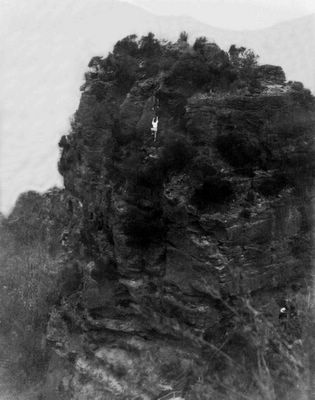
Throughout the 1930s, Eric Dark pioneered climbing in the Warrumbungles, a group of spectacular volcanic spires in western New South Wales. In 1933, he returned the area with a group from the Sydney Bush Walkers, including Marie Byles and Dot English (later Dot Butler). English’s habit of walking and climbing barefoot gave the name to her autobiography published some years later—The Barefoot Bushwalker. She recalled the experience: ‘This was my first introduction to technical climbing. Accustomed to rushing up and over rock faces barefoot and unroped, jumping for likely-looking holds, swinging about on scant bits of vegetation growing out of the cliffs, it was a new (and somewhat painful) experience to be tied on to a restraining rope, hooked over impeding belays, obliged to ‘stop and make sure two holds are secure before relinquishing the third’. Eric Dark was impressed with her climbing ability and they set out to climb Crater Bluff (pictured above). With them was a Polish climber, ‘Mr Paszek’, nicknamed ‘Pan’, who had climbed in the Dolomites in his youth and in the Swiss Alps as a member of the Tatra Mountaineering Club. They walked around to the Green Glacier, on the southern side of the Bluff, carrying a 60 metre rope. The first 200 metres was easy and then they roped up. It was here that 'Pan' turned back. The lithe Dot English took the lead and climbed up a steep crack in the face. Dark led through and reached the top. Perhaps influenced by news of the practice in Queensland, they lit a small fire on the summit to alert local people of their success but the inevitable happened—it spread and they were cut off from their descent route. Dark had to piggyback English across the embers as she had no footwear. On the same trip, Dark and Eric Lowe climbed all but the last 60 metres of what is known today as Diagonal Route on the north face of Crater Bluff.
Picture: Michael Meadows collection.


















